Development Of Dentition
Definitions
- Primate spaces/ Simian spaces / Anthropoid spaces
- These are spaces present mesial to the maxillary canines and distal to the mandibular canines
- Incisal liability
- The difference between the amount of space needed for the accommodation of incisors and the amount of space available is called incisal liability.
- Leeway space of Nance
- The differences between the combined mesiodistal width of deciduous canine and molars to the combined mesiodistal width of permanent canine and premolar is called the leeway space of Nance
Development Of Dentition Important Notes
1. Gum pads
- These are alveolar processes present at the time of birth
- They are developed in two parts – labiobuccal and lingual portion
- Both parts are separated by a dental groove
- Gum pads are divided into 10 segments by a transverse groove
- The groove between the canine and first deciduous molar called lateral sulci determines inter arch relationship.
2. Shift of lower molars from flush terminal plane to Class 1 occurs by
- Early shift – by utilizing primate spaces
- Late shift – by utilizing leeway space
3. Eruption sequence of deciduous teeth
- Lower central incisor
- Upper central incisor
- Lower lateral incisor
- Upper lateral incisor
- First molars
- Canines
- Second molars
4. Incisal liability values
- Mandibular arch – 5 mm
Read And Learn More: Pedodontics Short Essays Question And Answers
- Maxillary arch – 7 mm
5. Leeway space values
- Mandibular arch – 3.4 mm
- Maxillary arch – 1.8 mm
Development Of Dentition Short Essay
Question 1. Gumpads.
Answer:
- The alveolar processes at the time of birth are known as gum pads.
- They are pink, and firm.
- These are covered by a dense layer of fibrous periosteum.
- Shape: They are horse-shoe-shaped.
- Portions:
- Gumpads divide into the labio-buccal portion and the lingual portion by a dental groove.
- Gumpads are divided into ten segments by certain grooves called transverse grooves
- Transverse groove between the canine and the first deciduous molar segment is called the lateral sulcus which helps in the assessment of interarch relationship.
Upper and Lower Gumpads:
- Upper gum pads is wider and longer.
- When both are approximated contact occurs in the first molar region and a space exists in the anterior region.
- This space helps in suckling.



Question 2. Terminal Plane/ Molar relationship
Answer:
The mesial-distal relation between the distal surfaces of upper and lower second deciduous molars is called the terminal plane.
Types:
1. Flush Terminal Plane:
- Here, the distal surfaces of the upper and lower second deciduous molars are in the same vertical plane.
- It is a normal feature.
2. Mesial Step:
- In this type, the distal surface of the lower second deciduous molar is more mesial to the distal surface of the upper second deciduous molar.
- Thus the permanent molars erupt directly into Angle’s class 1 occlusion.
3. Distal Step:
- Here the distal surface of the lower second deciduous molar is more distal to the distal surface of the upper second deciduous molar.
- Thus the erupting permanent molar may be in Angle’s Class 2 occlusion.
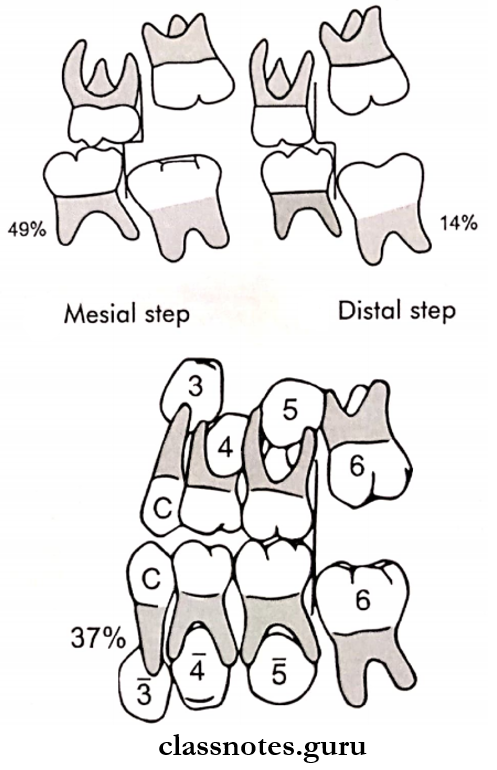
Question 3. Primate Spaces.
Answer:
- The spacing usually occurs in deciduous dentition.
- It is important for the normal development of dentition.
- The absence of these spaces leads to the crowding of teeth after the eruption of permanent teeth.
- It helps in the placement of canine cusps of opposing arches.
Site:
- Mesial to the maxillary canines.
- Distal to the mandibular canines.
Synonyms:
- Physiological space.
- Developmental space.
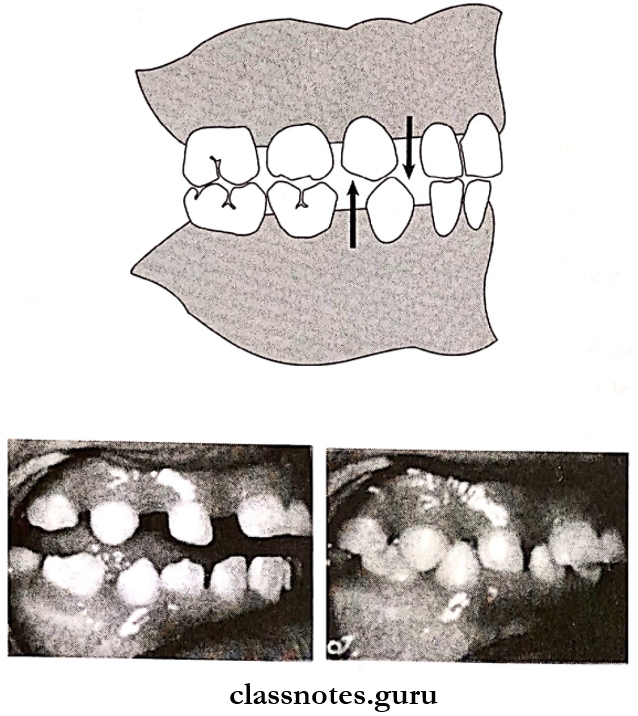
Question 4. Early and Late Mesial Shift.
Answer:
The shift in a lower molar from a flush terminal plane to a Class 1 relation can occur in 2 ways:
1. Early Shift:
- The forward movement of the first permanent molar utilizing the primate space is called early shift.
- The eruptive force of the first permanent molar pushes the deciduous first and second molars forward in the arch to close the primate space and thereby establish a Class 1 molar relationship.
2. Late Shift:
- Occurs in the late mixed dentition period.
- When the deciduous second molars exfoliate the permanent 1st molars drift mesially utilizing the leeway space.
- This is called a late shift.
Question5. Self-Correcting Anomalies.
(Or)
Transient malocclusions
Answer:
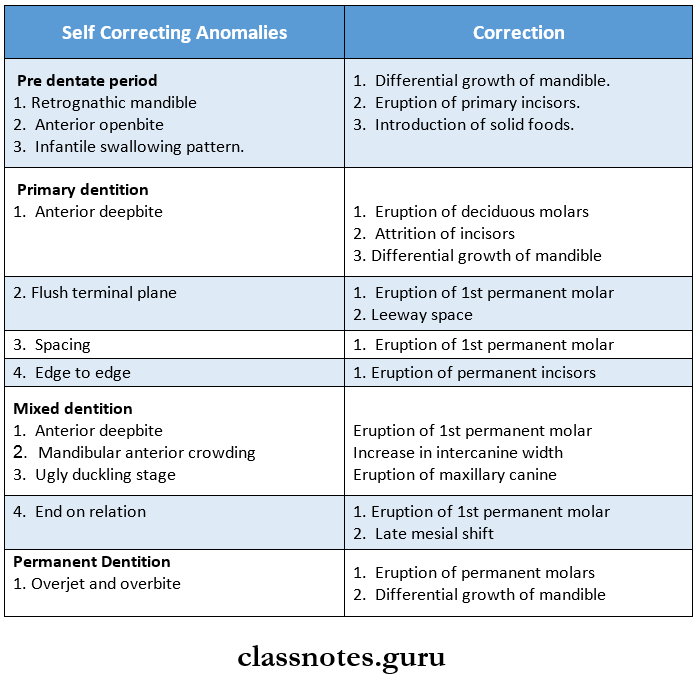
Question 6. Eruption and shedding sequence of primary teeth
Answer:
Eruption:
- The eruption was used to denote the tooth’s emergence through the gingiva
- Then, it become more completely defined to mean con- tenuous tooth movement from the dental bud to occlusal contact
- The order of eruption of deciduous teeth is as follows
- Lower central incisor
- Upper central incisor
- Lower lateral incisor
- Upper lateral incisor
- First molars
- Canines
- Second molars
Shedding
- The physiologic process results when disturbances in the form, color, arrangement, and structure of the teeth might have occurred
- The first sign is seen in deciduous central incisors and first molars by the age of 4-5 years
- Resorption of incisors begins primarily on the lingual side while that of molars starts from the inner surfaces of the developing permanent tooth germ
Development Of Dentition Short Answers
Question 1. Late mesial shift.
Answer:
- Occurs in the late mixed dentition period.
- When the deciduous second molars exfoliate the permanent 1st molars drift mesially utilizing the leeway space.
- This is called late shift.
Question 2. Features of primary dentition.
Answer:
- Both the dental arches are half-round in shape or ovoid
- Almost no curve of Spee is present
- Shallow cuspal interdigitation
- Slight over jet
- Deep bite
- The vertical inclination of the incisors
- Spaced dentition
- Different maxillo-mandibular relations like flush, mesial, and distal terminal planes
Question 3. Ugly Duckling Stage./ Broadbent phenomenon.
Answer:
- Given by Broadbent.
- It is a transient malocclusion seen in the maxillary incisor region between 8-9 years of age.
- This is seen during the eruption of the permanent canine.
- As the developing permanent canine erupts, they displace the roots of the lateral incisors mesially.
- This transmits the forces onto the roots of the central incisor which is also displaced mesially.
- This results in midline spacing.
- This situation is so named as the child looks ugly.
- This corrects itself when the pressure is transferred from the roots to the coronal area of the incisors.
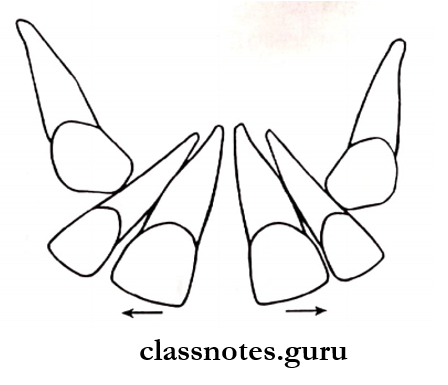
Question 4. Leeway Space of Nance.
Answer:
- The combined mesiodistal width of the permanent canines and premolars is usually less than that of the deciduous canines and molars.
- This space is called the Leeway space of Nance.
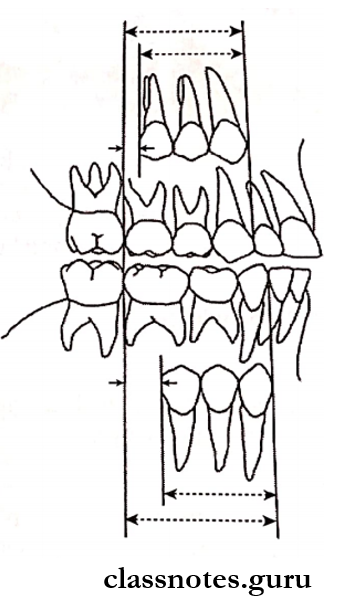
Value:
- It is greater in the mandibular arch.
- It is 1.8 mm in the maxillary arch and 3.4 mm in the mandibular arch.
Significance:
- This space is utilized for mesial drift of the mandibular molars to establish Class 1 molar relation.
Question 5. incisal Liability.
Answer:
- Permanent incisors replace deciduous incisors.
- Permanent incisors are larger ones.
- The difference between the amount of space needed for the accommodation of the permanent incisors and the place available for it is called incisal liability.
Value:
- It is a 5 mm in the mandibular arch and 7 mm in the maxillary arch.
- It is overcome by:
- Utilization of physiologic spaces.
- Increase in inter-canine width
- Change in incisor inclination.
Question 6. Growth Spurts.
Answer:
- A sudden increase in growth is called a growth spurt.
- It is different for boys and girls.
- It is believed due to hormonal secretion.
Timings:
- Just before birth
- One year after birth
- Mixed dentition
- Boys: 8-11 years
- Girls: 7-9 years
- Adolescent growth spurt
- Boys: 14-16 years
- Girls: 11-13 years
Question 7. Food guide pyramid
Answer:
- It is a pyramid-shaped guide of healthy foods divided into sections to show the recommended intake for each food group
- The first food guide pyramid was published in Sweden in 1974.
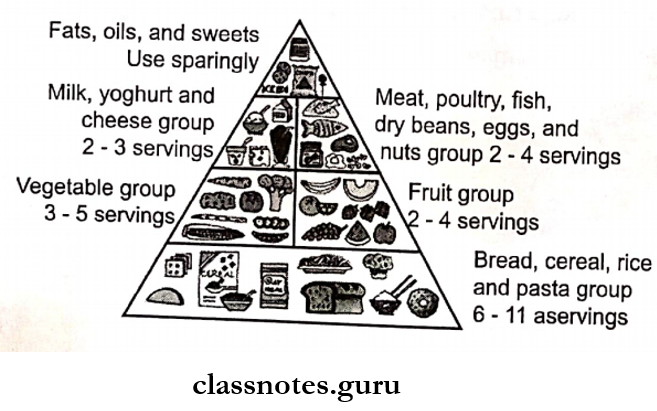
Question 8. Molar incisor hypomineralization
Answer:
- Molar Incisor Hypomineralisation is a type of enamel defect affecting the first molars and incisors in the permanent dentition.
- It usually occurs in children under 10 years old.
- It is caused by the lack of mineralization of enamel during its maturation phase, due to interruption to the function of ameloblasts.
Features:
- MIH often presents as discoloration on one to four affected permanent molars and the associated incisors.
- The enamel of the affected teeth appears yellow, brown, cream or white and thus are sometimes referred to as ‘cheese molars’.
- There is a difference in enamel translucency in the affected teeth
- The development of tooth decay is very rapid due to the less mineralised enamel
- MIH only becomes visible once the permanent molars start to erupt
Etiology:
- Children born preterm and those with poor general health or systemic conditions in their first 3 years
- Environmental changes
- Exposure to dioxin by prolonged breast-feeding could lead to an increase in the risk of MIH
- Respiratory diseases and oxygen shortage of the ameloblasts
- Oxygen shortage combined with low birth weight
Development Of Dentition Viva Voce
- Primate spaces help in the placement of canine cusps of the opposing arch.
- Initiation of primary dentition occurs in 6 weeks of IU life
- Broadbent coined the term ugly duckling stage
- Mandibular central incisors is first tooth to erupt in primary dentition
- Nance determined the leeway space
- The ugly duckling stage is seen between 8-9 years
